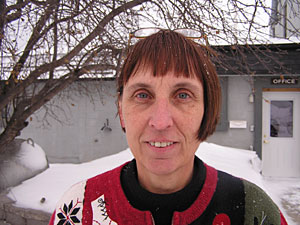 |
| Marilyn Durenberger's company -- Mid-States Mechanical Services in Mankato -- recently got socked with a 15-percent cost increase. (MPR Photo/Mark Steil) |
Worthington, Minn. — Almost every business executive has a vivid memory from the health-cost wars. For Marilyn Durenberger, of Mid-States Mechanical Services, it happened when her insurance agent told her to sit down and brace herself for bad news.
"We had a perfect storm of illnesses and medical expenses of employees that really caused a huge increase in our insurance premiums," says Durenberger.
Among the health problems for the company's 40 employees were cancer, heart problems and a benign brain tumor. The bills cost the Mankato company's insurer a lot of money. They raised Mid-States' insurance rates 15 percent. Other businesses have seen even higher one year jumps, but for Mid-States it represented a final blow of sorts. Business was slow in the company's main focus, building and installing industrial piping and insulation. The 15-percent hike culminated years of insurance increases. Durenberger says it seemed to be an end point.
"We were looking looking at the fact that we might not be able to continue to offer coverage to our employees," says Durenberger.
After delivering the bad news, her insurance agent outlined some possible options. The company chose what's known as a "consumer driven health care" plan. It couples a high deductible insurance policy with a popular new option called a Health Savings Account. Mid-States switched to the new policy in the summer of 2004.
"With increases the way they have been, you have to look at, is it better to have insurance that covers major expenditures or no insurance at all." says Durenberger.
Durenberger says the company saw a first-year savings of 20 percent in overall health spending. Each worker who signs up for the plan opens at Health Savings Account. The company makes an annual $1,000 contribution to the account. Employees can add more if they want. The money can be used for any type of medical expense, including mental health care and chiropractic services. The employee pays all medical bills with money from the HSA until they meet their yearly deductible, which ranges from $2,600 for singles to just over $5,000 for families.
After the deductible is met, insurance covers most remaining bills. Marilyn Durenberger is happy the company switched to the new approach. The type of savings her company and others have found are attracting attention.
FROM FAD TO FAVOR
Steve Parente is with the University of Minnesota's Carlson School of Management and keeps a close watch on health insurance issues. He says the Health Savings Account option has moved from fad to broad-based option.
"You suddenly see almost every major insurer offering a consumer-driven health plan," Parente says. "Whereas two years ago, or three years ago , this was considered just a complete niche market and something like a dot-com company that would just fall away. And the fact that there's been that much a response, the fact that the federal government offers it, the fact that George Bush took one up, that's pretty significant."
A Minnesota Chamber of Commerce study shows a quarter of state businesses offer employees a Health Savings Account, with another quarter likely to do so in the coming years. The interest reflects a desire in business to try something new. A Chamber survey found that health care cost is the number-one concern of Minnesota businesses, topping even taxes.
Employer provided insurance is by far the single most important source of health coverage for U.S. workers. Many companies though are changing what they do. Businesses which once paid employee's insurance premium now require workers to share the bill. Some are taking more drastic steps.
Scott Peterson, who owns an auto body shop in southern Minnesota, dropped employee coverage because it got too expensive.
"Between the cost of insurance and the cost of just general doing business, we had to make some concessions here and there," says Peterson. "And that was one of the areas that had to get cut."
Peterson says some years he saw insurance costs rise more than 25 percent. He says in a business with eight employees, there was no way to absorb the yearly increases.
"My feeling is, is it hurts small business owners probably more than large corporations. We don't have a big group to spread things out over," says Peterson. "I mean I can't pass the costs along to my consumers or the insurance companies that we're dealing with. It just won't happen."
Studies seem to agree with Peterson. A report done for the federal government shows small companies are less likely to offer health insurance than large ones. Only 40 percent of employees in companies with fewer than 10 workers have access to health insurance. In large corporations nearly all employees have the option.
Scott Peterson says he's aware of Health Savings Accounts, but right now they're too expensive for his business. That will be one of the real tests of the new approach. Can the high-deductible plans reduce costs enough to entice business owners like Peterson back into the employee insurance field? It's too early too know.
RESISTING CHANGE
Health Savings Accounts have some major hurdles to overcome before they exert widespread influence on the system. One has do to with human nature. The University of Minnesota's Steve Parente says people just don't like changing health policies.
"There's what's known as a very high persistence in keeping the same plan you have," says Parente. "In part because there is an underlying risk aversion to all this. If you have relationships either built up with the insurer or the provider, you don't really want to gamble on those."
Parente estimates about 5 percent of workers in the state have a Health Savings Account. Another figure though may be more predictive. Parente says when given a choice, about 15 percent of employees voluntarily choose the Health Savings Account option. Depending on your viewpoint, that may seem low or high. For Parente it's better than expected, given human nature.
For others it says employees are wary of Health Savings Accounts. Sean Kenney says for good reason. He's the executive director of the Labor Management Health Care Coalition of the Upper Midwest.
"It's a big buzzword right now and it's not always good in the way it's playing out," says Kenney.
UNIONS OPPOSED
Many unions oppose the high-deductible, Health Savings Account approach. Kenney says too often it's a way for management to shift health care costs from the company to the worker. Kenney says a fairer approach is reducing the cost of health care for everyone. He says the best way to do that is to find top quality care at the best price. His organization is trying to do that. Kenney's group has access to detailed information about the service records of different hospitals. For a specific operation, say open heart surgery, it can inform a consumer which hospital has the lowest death rate, the fewest complications, the best price. Kenney says his group urges its members to use the information in choosing a doctor.
"We're saying we don't want to do business with everyone in the Yellow Pages, everyone that's got a shingle out there," says Kenney. "We want to find out the best, and it's not always in Minnesota."
Kenney believes if enough people use this approach it will lead to increased competition for patients among doctors and hospitals. That, he believes, will lead to lower health care and insurance prices. Despite labor's general wariness, competition is one point of agreement they have with management advocates of Health Savings Accounts.
Mike Finger is president of Nonprofit Solutions in St. Paul. His 30 employees switched to Health Savings Accounts about three months ago. He says since it's their money, employees will naturally seek out the best quality care at the best price.
"The biggest benefit that comes from that in my mind is that it gets employees involved in the process," says Finger. "A participant in seeing that that visit actually didn't just cost their $20 co-pay, it cost $400."
He says when they start calculating costs, employees might decide against a certain procedure and seek a cheaper option. Health Savings Account supporters say that simple bit of thinking could be the start of a series of events which transform health care, leading to more competition and lower costs. Others though are less certain. They worry health costs are rising so fast that any efforts at change are quickly overwhelmed by higher prices.





